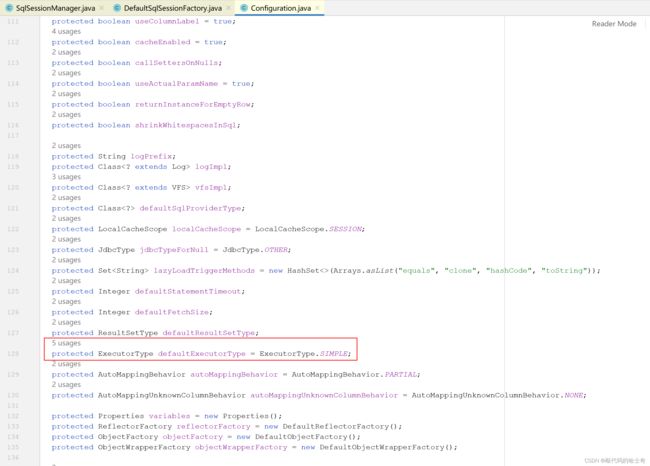Mybatis优化:使用batch模式实现批量插入/更新
目录
demo
工具类
Mybatis原理简介
SqlSessionFactoryBuilder
SqlSessionFactory
SqlSession
Mybatis开启Batch模式
Batch模式效率高的原因
参考文档
Mybatis中有两种批量插入的方式:
- 动态SQL使用foreach标签进行批量插入
- 使用Mybatis的batch模式进行批量插入
相比之下,数据量较大的场景中后者效率更高
demo
public void demo(){
SqlSession session = sqlSessionFactory.openSession(ExecutorType.BATCH, false);
try {
for (Dept dept : deptList) {
baseManager.insert(dept);
}
session.commit();
}catch (Exception e){
session.rollback();
}finally {
session.close();
}
}工具类
package com.utils.sql;
import com.utils.SpringUtils;
import java.util.List;
import java.util.function.BiConsumer;
import lombok.extern.slf4j.Slf4j;
import org.apache.ibatis.session.ExecutorType;
import org.apache.ibatis.session.SqlSession;
import org.apache.ibatis.session.SqlSessionFactory;
/**
* @author yms
* @description: Mybatis 批量insert、update工具类
* @date: 2023/7/3 17:21
*/
@Slf4j
public class BatchDmlUtil {
/**
* 批量新增方法
*
* @param list 要新增的集合
* @param clazz Mapper类
* @param biConsumer 对应的单条新增方法
* @param mapper类型
* @param 结合元素类型
*/
public static void batchOperate(List list, Class clazz, BiConsumer biConsumer) {
if (list == null || list.size() == 0) {
log.info("BatchDmlUtil batchInsert list data is null!");
return;
}
SqlSessionFactory sqlSessionFactory = SpringUtils.getBean(SqlSessionFactory.class);
SqlSession session = sqlSessionFactory.openSession(ExecutorType.BATCH);
try {
M mapper = session.getMapper(clazz);
list.forEach(a -> {
biConsumer.accept(mapper, a);
});
session.commit();
session.clearCache();
} catch (Exception e) {
e.printStackTrace();
log.error("BatchDmlUtil batchInsert is exception!clazz={}", clazz.getName(), e);
session.rollback();
} finally {
session.close();
}
}
}
package com.utils;
import org.springframework.aop.framework.AopContext;
import org.springframework.beans.BeansException;
import org.springframework.beans.factory.NoSuchBeanDefinitionException;
import org.springframework.beans.factory.config.BeanFactoryPostProcessor;
import org.springframework.beans.factory.config.ConfigurableListableBeanFactory;
import org.springframework.stereotype.Component;
/**
* spring工具类 方便在非spring管理环境中获取bean
*/
@Component
public final class SpringUtils implements BeanFactoryPostProcessor {
/** Spring应用上下文环境 */
private static ConfigurableListableBeanFactory beanFactory;
@Override
public void postProcessBeanFactory(ConfigurableListableBeanFactory beanFactory) throws BeansException {
SpringUtils.beanFactory = beanFactory;
}
/**
* 获取对象
*
* @param name
* @return Object 一个以所给名字注册的bean的实例
* @throws org.springframework.beans.BeansException
*/
@SuppressWarnings("unchecked")
public static T getBean(String name) throws BeansException {
return (T) beanFactory.getBean(name);
}
/**
* 获取类型为requiredType的对象
*
* @param clz
* @return
* @throws org.springframework.beans.BeansException
*/
public static T getBean(Class clz) throws BeansException {
T result = (T) beanFactory.getBean(clz);
return result;
}
/**
* 如果BeanFactory包含一个与所给名称匹配的bean定义,则返回true
*
* @param name
* @return boolean
*/
public static boolean containsBean(String name) {
return beanFactory.containsBean(name);
}
/**
* 判断以给定名字注册的bean定义是一个singleton还是一个prototype。
* 如果与给定名字相应的bean定义没有被找到,将会抛出一个异常(NoSuchBeanDefinitionException)
*
* @param name
* @return boolean
* @throws org.springframework.beans.factory.NoSuchBeanDefinitionException
*/
public static boolean isSingleton(String name) throws NoSuchBeanDefinitionException {
return beanFactory.isSingleton(name);
}
/**
* @param name
* @return Class 注册对象的类型
* @throws org.springframework.beans.factory.NoSuchBeanDefinitionException
*/
public static Class getType(String name) throws NoSuchBeanDefinitionException {
return beanFactory.getType(name);
}
/**
* 如果给定的bean名字在bean定义中有别名,则返回这些别名
*
* @param name
* @return
* @throws org.springframework.beans.factory.NoSuchBeanDefinitionException
*/
public static String[] getAliases(String name) throws NoSuchBeanDefinitionException {
return beanFactory.getAliases(name);
}
/**
* 获取aop代理对象
*
* @param invoker
* @return
*/
@SuppressWarnings("unchecked")
public static T getAopProxy(T invoker) {
return (T) AopContext.currentProxy();
}
}
Mybatis原理简介
每个基于 MyBatis 的应用都是以一个 SqlSessionFactory 的实例为核心的。SqlSessionFactory 的实例可以通过 SqlSessionFactoryBuilder 获得。而 SqlSessionFactoryBuilder 则可以从 XML 配置文件或一个预先配置的 Configuration 实例来构建出 SqlSessionFactory 实例。
//使用SqlSessionFactoryBuilder创建SqlSessionFactory
String resource = "org/mybatis/example/mybatis-config.xml";
InputStream inputStream = Resources.getResourceAsStream(resource);
SqlSessionFactory sqlSessionFactory = new SqlSessionFactoryBuilder().build(inputStream);
//使用SqlSessionTemplate创建SqlSessionFactory
@Autowired
private SqlSessionTemplate sqlSessionTemplate;
SqlSessionFactory sqlSessionFactory = sqlSessionTemplate.getSqlSessionFactory();
SqlSessionFactoryBuilder
SqlSessionFactoryBuilder可以理解为SqlSessionFactory的建造者,其作用是用来创建SqlSessionFactory,需要注意的是SqlSessionFactoryBuilder不是线程安全的。在spring项目中我们可以使用SqlSessionTemplate来创建SqlSessionFactory,SqlSessionTemplate是线程安全的。
SqlSessionFactory
SqlSessionFactory用来创建SqlSession实例。SqlSessionFactory 一旦被创建就应该在应用的运行期间一直存在,没有任何理由丢弃它或重新创建另一个实例。 使用 SqlSessionFactory 的最佳实践是在应用运行期间不要重复创建多次,多次重建 SqlSessionFactory 被视为一种代码“坏习惯”。因此 SqlSessionFactory 的最佳作用域是应用作用域。 有很多方法可以做到,最简单的就是使用单例模式或者静态单例模式。
SqlSession
SqlSession是mybatis的顶层API,其作用是访问数据库,完成增删改查以及事务的提交和回滚等操作。SqlSession实例不是线程安全的,不能被多个线程共享。
Mybatis开启Batch模式
Mybatis在枚举中提供了三种类型的执行器
package org.apache.ibatis.session;
/**
* @author Clinton Begin
*/
public enum ExecutorType {
SIMPLE, //mybatis的默认执行器,它为每个语句的执行创建一个新的预处理语句
REUSE, //会复用预处理语句
BATCH //会批量执行所有更新语句,不需要对同样的SQL进行多次预编译
}
从org.apache.ibatis.session.Configuration类中可以看到Mybatis模式是simple模式
使用SqlSessionFactory创建一个Batch类型的SqlSession实例
SqlSessionFactory sqlSessionFactory = sqlSessionTemplate.getSqlSessionFactory();
SqlSession sqlSession = sqlSessionFactory.openSession(ExecutorType.BATCH);SqlSessionFactory中有多个创建SqlSession实例的方法,我们可以根据自己的实际需求调用不同的方法
package org.apache.ibatis.session;
import java.sql.Connection;
/**
* Creates an {@link SqlSession} out of a connection or a DataSource
* SqlSessionFactory源码
* @author Clinton Begin
*/
public interface SqlSessionFactory {
SqlSession openSession();
SqlSession openSession(boolean autoCommit);
SqlSession openSession(Connection connection);
SqlSession openSession(TransactionIsolationLevel level);
SqlSession openSession(ExecutorType execType);
SqlSession openSession(ExecutorType execType, boolean autoCommit);
SqlSession openSession(ExecutorType execType, TransactionIsolationLevel level);
SqlSession openSession(ExecutorType execType, Connection connection);
Configuration getConfiguration();
}
SqlSessionFactory有两个实现类:DefaultSqlSessionFactory和SqlSessionManager
最终在DefaultSqlSessionFactory.openSessionFromDataSource()方法中生成Mybatis的执行器
private SqlSession openSessionFromDataSource(ExecutorType execType, TransactionIsolationLevel level, boolean autoCommit) {
Transaction tx = null;
try {
final Environment environment = configuration.getEnvironment();
final TransactionFactory transactionFactory = getTransactionFactoryFromEnvironment(environment);
tx = transactionFactory.newTransaction(environment.getDataSource(), level, autoCommit);
//创建Executor
final Executor executor = configuration.newExecutor(tx, execType);
return new DefaultSqlSession(configuration, executor, autoCommit);
} catch (Exception e) {
closeTransaction(tx); // may have fetched a connection so lets call close()
throw ExceptionFactory.wrapException("Error opening session. Cause: " + e, e);
} finally {
ErrorContext.instance().reset();
}
}org.apache.ibatis.session.Configuration.newExecutor()
public Executor newExecutor(Transaction transaction, ExecutorType executorType) {
executorType = executorType == null ? defaultExecutorType : executorType;
executorType = executorType == null ? ExecutorType.SIMPLE : executorType;
Executor executor;
//判断,如果是BATCH模式,则创建BatchExecutor
if (ExecutorType.BATCH == executorType) {
executor = new BatchExecutor(this, transaction);
} else if (ExecutorType.REUSE == executorType) {
executor = new ReuseExecutor(this, transaction);
} else {
executor = new SimpleExecutor(this, transaction);
}
if (cacheEnabled) {
executor = new CachingExecutor(executor);
}
executor = (Executor) interceptorChain.pluginAll(executor);
return executor;
}Batch模式效率高的原因
Batch中减少了SQL预编译的次数,单次插入数据量特别大,字段特别多的情况下更适合使用Mybatis的Batch模式。
BatchExecutor.doUpdate()
public int doUpdate(MappedStatement ms, Object parameterObject) throws SQLException {
final Configuration configuration = ms.getConfiguration();
final StatementHandler handler = configuration.newStatementHandler(this, ms, parameterObject, RowBounds.DEFAULT, null, null);
final BoundSql boundSql = handler.getBoundSql();
final String sql = boundSql.getSql();
final Statement stmt;
//判断如果当前SQL与上一次传入的SQL一样则不会创建新的Statement
if (sql.equals(currentSql) && ms.equals(currentStatement)) {
int last = statementList.size() - 1;
//直接取上次的Statement
stmt = statementList.get(last);
applyTransactionTimeout(stmt);
handler.parameterize(stmt);// fix Issues 322
BatchResult batchResult = batchResultList.get(last);
batchResult.addParameterObject(parameterObject);
} else {
Connection connection = getConnection(ms.getStatementLog());
stmt = handler.prepare(connection, transaction.getTimeout());
handler.parameterize(stmt); // fix Issues 322
currentSql = sql;
currentStatement = ms;
statementList.add(stmt);
batchResultList.add(new BatchResult(ms, sql, parameterObject));
}
handler.batch(stmt);
return BATCH_UPDATE_RETURN_VALUE;
}SimpleExecutor.doUpdate()
public int doUpdate(MappedStatement ms, Object parameter) throws SQLException {
Statement stmt = null;
try {
Configuration configuration = ms.getConfiguration();
StatementHandler handler = configuration.newStatementHandler(this, ms, parameter, RowBounds.DEFAULT, null, null);
//创建新的Statement
stmt = prepareStatement(handler, ms.getStatementLog());
return handler.update(stmt);
} finally {
closeStatement(stmt);
}
}
private Statement prepareStatement(StatementHandler handler, Log statementLog) throws SQLException {
Statement stmt;
Connection connection = getConnection(statementLog);
stmt = handler.prepare(connection, transaction.getTimeout());
handler.parameterize(stmt);
return stmt;
}参考文档
MyBatis中文网
mybatis-spring –
